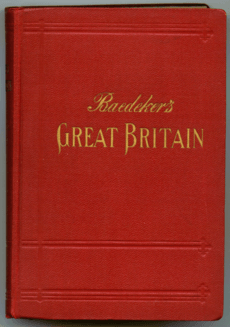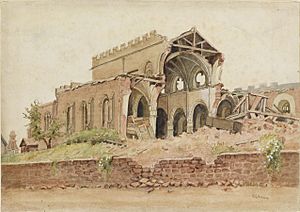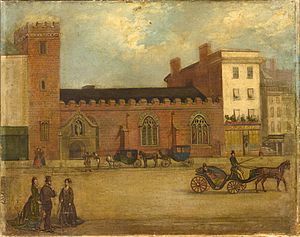Baedeker Blitz facts for kids
Quick facts for kids Baedeker Blitz |
|||||||
|---|---|---|---|---|---|---|---|
| Part of the Western Front of World War II | |||||||
|
|||||||
| Belligerents | |||||||
| Commanders and leaders | |||||||
| Strength | |||||||
|
Luftflotte 3
|
||||||
| Casualties and losses | |||||||
|
|
||||||
The Baedeker Blitz was a series of air attacks by the German air force, the Luftwaffe, on English cities during World War II. These attacks happened in April and May 1942. The name "Baedeker Blitz" comes from Baedeker, which were popular German tourist guide books. These books had detailed maps. The Germans used them to pick cities to bomb.
The raids were a response to the Royal Air Force's (RAF) bombing attacks on German cities. The RAF had started bombing German cities more effectively in March 1942. Germany wanted to get back at Britain. They hoped these attacks would make the RAF stop bombing Germany. The German bombers chose cities with important cultural and historical sites, not military targets. They wanted to hurt British people's spirits.
Most of these raids happened in April and May 1942. However, German planes kept bombing cultural cities for the next two years.
Overall, the Baedeker Blitz was not successful for Germany. The RAF had much better night fighter planes and new radar technology. The Luftwaffe lost too many bombers. The damage to British cities was also much less than during the earlier German bombing campaign (the Blitz). It was also less than the damage the RAF was causing in Germany. Still, these raids killed over 1,600 civilians. They also damaged tens of thousands of homes.
Contents
Why the Baedeker Blitz Started
By late 1941, both British and German bombing campaigns were not very effective. The German bombing of Britain, known as the Blitz, had ended in May 1941. This was because the Luftwaffe moved its planes to invade the Soviet Union. After that, Germany only did small, quick raids on British coastal towns. The RAF's night bombing of Germany was also not working well.
Things changed when the RAF started bombing again in March 1942. They used new, powerful bombers like the Stirling and Lancaster. They also had better navigation systems and new leaders. The RAF started using new tactics. Instead of trying to hit single factories, they bombed large areas. This included homes and people's spirits.
Planning the Attacks
The destruction of German cities like Lübeck and Rostock shocked German leaders. Until then, the German people had not felt much impact from the RAF's bombs. Joseph Goebbels, a German leader, said the damage was "enormous." He worried that if the British attacks continued, they would upset the German people.
Adolf Hitler was very angry. On April 14, 1942, he ordered the Luftwaffe to attack England more aggressively. He said they should choose targets that would affect civilian life the most. He wanted "retaliatory attacks" on cities other than London.
After a raid on Bath, Goebbels said Hitler wanted to "repeat these raids night after night." Hitler believed this was the only way to make the British "come to their senses."
Where the Name Came From

Both sides called these attacks "Baedeker raids." This name came from a comment by a German spokesman, Gustav Braun von Stumm. On April 24, 1942, he reportedly said, "We shall go out and bomb every building in Britain marked with three stars in the Baedeker Guide." This was a joke about the popular travel guides.
Goebbels was very angry about this comment. He wanted to say that British attacks were "terror bombing." He wanted German attacks to be seen as "retaliatory measures." Stumm's comment made it seem like Germany was targeting cultural sites on purpose. This was exactly what the German leaders did not want to admit.
The Raids Begin
German bomber groups, mainly from Luftflotte 3, carried out the attacks. Each raid used 30 to 40 planes. They often flew two bombing missions per night. Each mission lasted 60 to 90 minutes.

The first Baedeker Blitz raid was on Exeter on April 23/24, 1942. Exeter is an old city with many historic buildings. This first raid caused little damage. A second raid the next night was worse, killing over 80 people. On April 25/26 and 26/27, German bombers attacked Bath. This caused widespread damage and about 400 casualties.
On April 27/28, the Luftwaffe attacked Norwich. They dropped over 90 tons of bombs and killed 67 people. The next night, April 28/29, they attacked York. This caused limited damage but killed 79 people.
On May 3/4, the Luftwaffe returned to Exeter. They caused heavy damage to the city center and the Exeter Cathedral. This raid killed 164 people. The next night, they attacked Cowes, which was a cultural and military target.
In May, the Luftwaffe also bombed Hull (a major port), Poole, Grimsby, and Canterbury. The raid on Canterbury happened at the same time as the RAF's first "thousand-bomber raid" on Cologne. This raid involved 77 German bombers and killed 43 people.
In total, these raids killed 1,637 civilians and injured 1,760. Over 50,000 houses were destroyed or damaged. Some famous buildings were hit, like York's Guildhall and the Bath Assembly Rooms. But most important buildings, like the cathedrals of Norwich and Canterbury, and York Minster, were saved.
The German bombers suffered heavy losses. Germany also needed planes for fighting in North Africa and on the Eastern Front. This meant they could only continue smaller attacks.
What Happened Next
The term "Baedeker Blitz" mostly refers to the raids on Exeter, Bath, Canterbury, Norwich, and York in April and May 1942. However, the Luftwaffe kept targeting cities for their cultural value for the next two years.
In June 1942, they attacked Ipswich, Poole, and Canterbury again. They also hit Southampton (a port), Norwich again, and Weston-super-Mare. In July, they bombed industrial cities like Birmingham, Middlesbrough, and Hull. In August, they returned to "Baedeker" targets: Norwich, Swansea, Colchester, and Ipswich.
These later raids were smaller, usually with about 20 planes. This was because Germany was losing more and more planes. Britain's night-fighter defenses were getting better. By autumn, one German bomber group had lost 65 of its 88 crews. The attacks almost stopped.
To keep up the pressure, the Luftwaffe tried new tactics. They used special high-flying bombers that flew very high over southern England. These planes were safe for a few weeks. One raid on Bristol killed 48 people. But the RAF soon used modified Spitfires to stop them.
On October 31, 1942, German fighter-bombers attacked Canterbury at a low level. They dropped 28 bombs and killed 30 people. Three German planes were shot down.
By the end of 1942, 3,236 people had been killed and 4,148 injured in these raids. The German air force in the west became weaker. Meanwhile, the RAF grew stronger. They regularly sent 200 or more planes to bomb Germany.
In 1943, the Luftwaffe in the west got stronger again. They renewed their attacks. In January 1943, they raided London. After a quiet February, they returned in March. This led to the Bethnal Green Tube disaster, where 178 people died in a crowded air raid shelter.
Throughout 1943, Germany bombed various targets. Some were military targets like Southampton and Plymouth. Others had little military value, like Eastbourne and Cheltenham. New tactics were tried, like using "butterfly bombs" in a raid on Grimsby. These bombs had delayed fuses, causing 163 civilian casualties as people returned home.
In November 1943, after the RAF bombed Hamburg, the Luftwaffe used their own radar jamming technique called Duppel. This made British radar useless, but the raid on Norwich still caused little damage. German crews were less experienced due to heavy losses.
By the end of 1943, Germany had dropped about 2,320 tons of bombs. This caused 2,372 deaths and 3,450 injuries. In comparison, the RAF dropped 136,000 tons of bombs that year. One single RAF raid on Berlin dropped more bombs than Germany's entire effort for the year.
The Baedeker-type raids ended in 1944. Germany realized they were not working. They were losing too many planes for little gain. In January 1944, Germany switched to bombing London as its main target. This attack, called Operation Steinbock, also failed. After this, Germany focused on ports that they thought the Allies would use to invade France. London then became the target for Germany's new V-weapons (long-range rockets).
See also
- Strategic bombing during World War II
- Operation Diver
- Operation Gisela



